Best Smart Thermostat 2025: Smarter Savings & Eco-Friendly Living
Find the best smart thermostat 2025 for energy savings and greener living. This friendly guide reviews top picks (Nest, Ecobee, Amazon, etc.), explains how smart thermostats cut your bills, and offers a simple buying guide for beginners.
Table of Contents
Switching to a smart thermostat can feel like upgrading from a flip phone to a smartphone for your home’s heating. In a nutshell, smart thermostats connect to Wi-Fi and learn your schedule, letting you remotely control the temperature and even “talk” to Alexa or Google for hands-free adjustments. They not only make life more convenient, but they can also cut energy use and emissions. In fact, TechRadar notes smart thermostats let you “remotely control your home temperature” to help reduce both your energy bills and your environmental footprint. Energy experts agree: these devices often trim heating and cooling costs by about 10–15%. In practical terms, if your annual HVAC bill is ~$1,000, you could save $50–150 a year. For the average American home, heating and cooling is nearly half the energy bill (over $900 annually), so even a small percentage saved is a big deal. In short, the best smart thermostat 2025 models pay for themselves over time, all while keeping you comfortable and eco-friendly.
Best Smart Thermostat 2025: Why You Need One
Imagine coming home on a chilly evening to find your house already cozy without ever adjusting a dial. That’s the promise of a smart thermostat. By learning when you’re home or away, these thermostats automatically schedule heating and cooling, and even respond to the weather outside. For example, one review highlights the new Nest Learning Thermostat as “AI-powered” and “more context-aware of environmental factors such as outside conditions” to save you even more money. It’s like having a small climate-control robot that remembers your preferences. Smart thermostats can use geofencing (detecting your phone’s location) to switch to “away” mode, or learn your routine so it never heats an empty house. Think of it as a thermostat with a brain: it gently nudges energy use down without sacrificing comfort.
Quick Savings Tip: ENERGY STAR-certified thermostats are tested to deliver real savings. Look for the ENERGY STAR label – it means the device meets strict efficiency criteria. ENERGY STAR even offers tips: most certified smart thermostats include remote app control, geofencing, learning schedules, and over-the-air updates to boost efficiency. These features help ensure your heating/cooling only runs when you need it.
Best Smart Thermostat 2025: How They Save Energy
Smart thermostats bring together a few key features to shrink your utility bills:
- Remote Control: Using your smartphone, you can adjust the temperature from anywhere. Forgot to turn off the heat? No problem – switch it off on your phone as you leave for work.
- Geofencing: Many models detect when you’ve left home (via GPS on your phone) and automatically set back the temperature to save energy. When you head home, it can preheat or precool so you arrive to a comfortable house.
- Learning Schedules: Thermostats like Google Nest will “learn” your preferences. For instance, Project Drawdown notes smart thermostats “save 10–15 percent of energy needs” by remembering your choices and routines. In practice, studies have found about 10–12% monthly savings on heating/cooling bills when smart thermostats adjust automatically.
- Occupancy & Sensors: Advanced thermostats (like Ecobee) include motion sensors that detect when a room is empty. If no one’s around, they won’t waste energy heating or cooling that area. This zonal control prevents heating unused rooms, further cutting waste.
- Over-the-Air Updates: Just like a smartphone, smart thermostats can update themselves with new algorithms. This means ongoing tweaks to improve efficiency.
Even small efficiencies add up. As one expert summary explains, if your old thermostat ran 24/7 at one setting, a smart thermostat cutting back 10% of that could save $50+ per year on average. Over the device’s lifetime, those savings often exceed its initial cost. For example, Project Drawdown estimates smart thermostats could save owners $1.8–2.0 trillion on utility bills globally over time – a hefty payoff! On a home scale, that might mean you recoup the cost in 2–3 years, after which it’s all extra savings.
Best Smart Thermostat 2025: Top Picks & Reviews
Here are the hottest smart thermostats of 2025. I’ve included a range of options so you can find the one that fits your home and budget. (Prices are approximate and may vary – look for deals on Amazon USA.)
- Google Nest Learning Thermostat (Gen 4) – Best overall smart thermostat. Google’s flagship is a beauty: a sleek, bezel-free glass display available in colors like Polished Silver and Gold. It learns your temperature habits and uses AI to create an optimal schedule. According to TechRadar, it’s “worth every penny” after months of testing thanks to its advanced AI scheduling and design. It’s Matter-compatible (works across most smart home platforms) and can control itself based on whether you’re home.
- Drawback: It’s US/Canada only and on the pricey side (~$280), but if you want the absolute top-performing model, this is it. (Buy on Amazon USA )
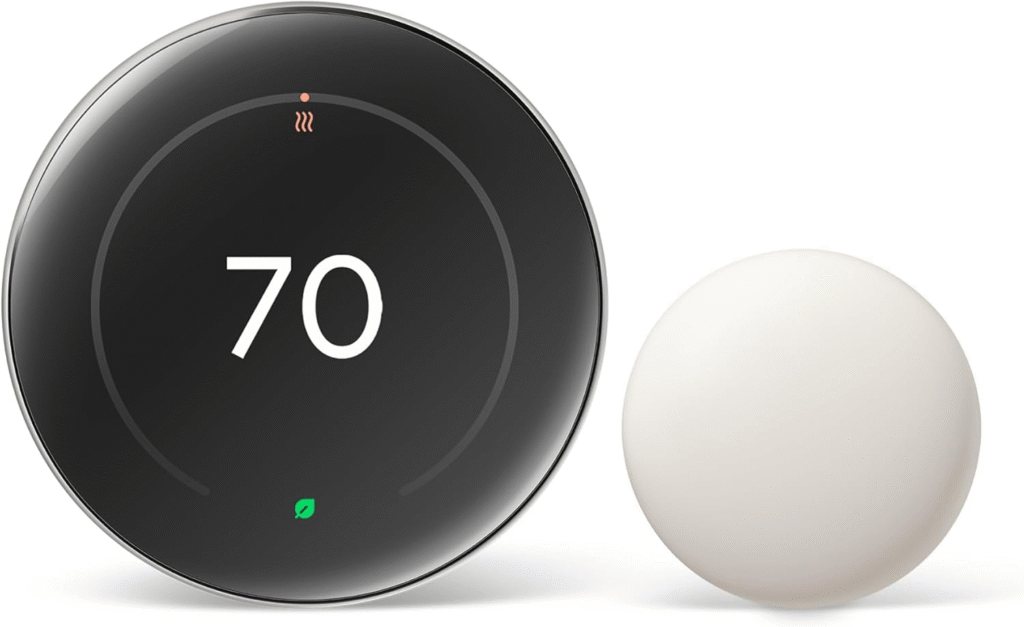
Google’s Nest Learning Thermostat Gen 4 uses AI to adapt to your habits and even responds to outside weather to save energy.
- Ecobee SmartThermostat Premium – Best smart thermostat for sensors & Alexa. Ecobee’s top model comes with built-in Alexa voice control and advanced room sensors. Tom’s Guide found it “remains the best smart thermostat” they’ve tested, thanks to its integrated speaker and occupancy sensing. The Premium (about $250) includes a remote sensor that detects presence, so it only heats occupied rooms. It also shows weather and music info on its touchscreen. Ecobee is a great choice if you’re in the Amazon ecosystem and want robust features. (Available on Amazon USA –)
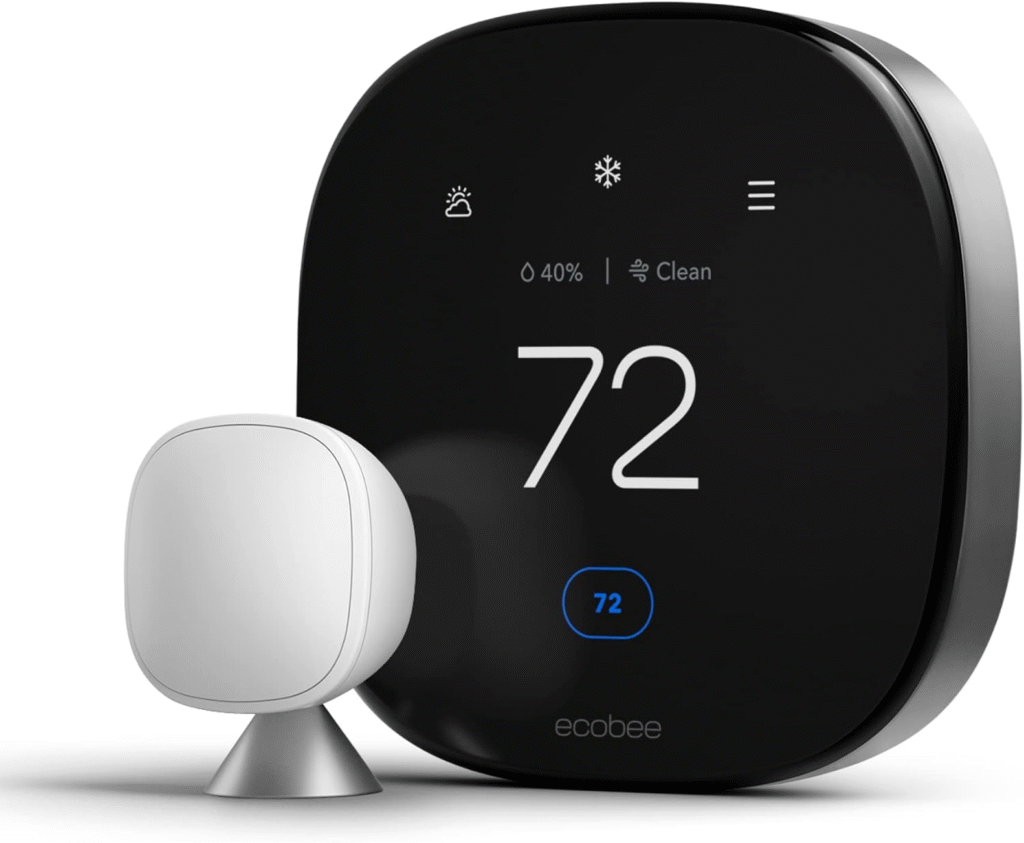
- Amazon Smart Thermostat – Best budget Alexa thermostat. If you just want simple Alexa integration, Amazon’s own thermostat is a steal (~$50–80). It works “flawlessly with Alexa,” and our friends at Listful praise it as a “cost-effective entry point” into smart climate control. It uses Alexa for all voice commands (“Alexa, set the temperature to 70”), and the app guides you through easy installation. It includes adaptive scheduling and even provides energy usage reports to help you save. The catch: it requires a C-wire, so older homes may need a power adapter kit. But for the price, it’s hard to beat if you’re on a budget.
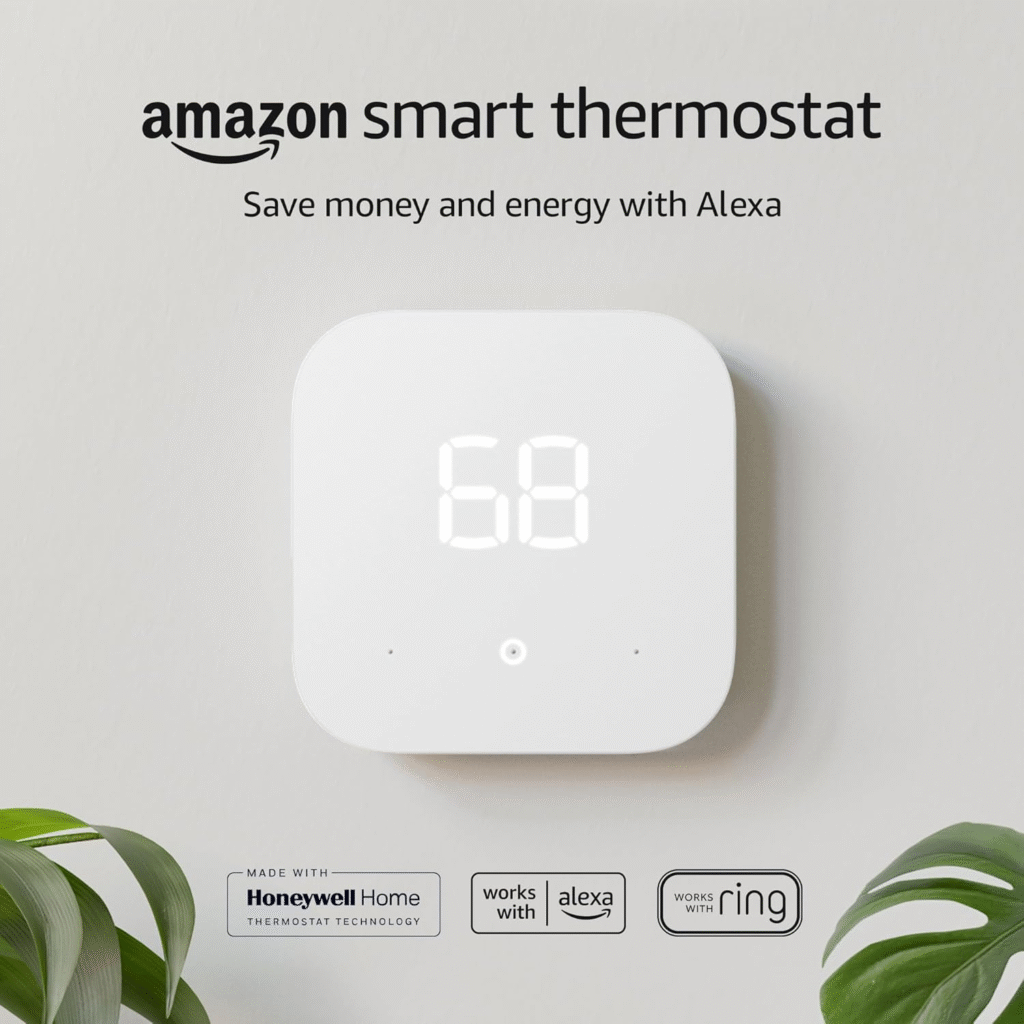
- Honeywell Home Smart Color Thermostat – Best for style and energy tracking. This model (around $180) adds a splash of color to your wall with a high-resolution screen you can customize. Honeywell’s gadget “is as smart as it is stylish,” letting you pick the display color and giving clear energy-usage insights. It handles normal scheduling features and works with Alexa or Google Assistant. I like it if you want a thermostat that doubles as decor and still keeps tabs on your heating costs. (Check Amazon USA )
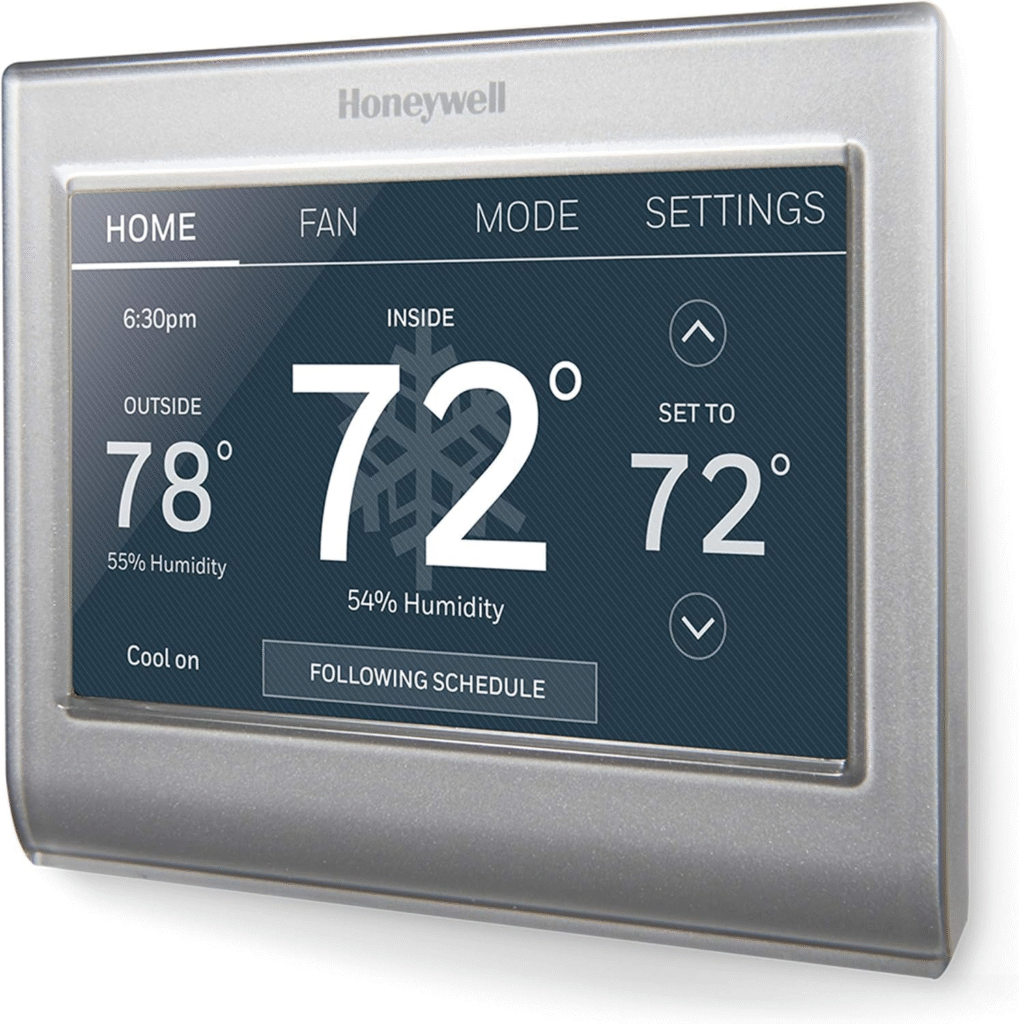
- Emerson Sensi Touch Smart Thermostat – Easiest install & voice-friendly. Sensi thermostats are well-known for simple DIY installation. The Touch version (~$147) has a big responsive touch screen and supports all voice assistants (Alexa, Google, and Siri via HomeKit). Listful notes it has a “user-friendly interface” and voice compatibility. You may need a C-wire here too, but once set up it’s straightforward. It’s a solid midrange pick if you want something smart but not too complicated. (Amazon USA –)
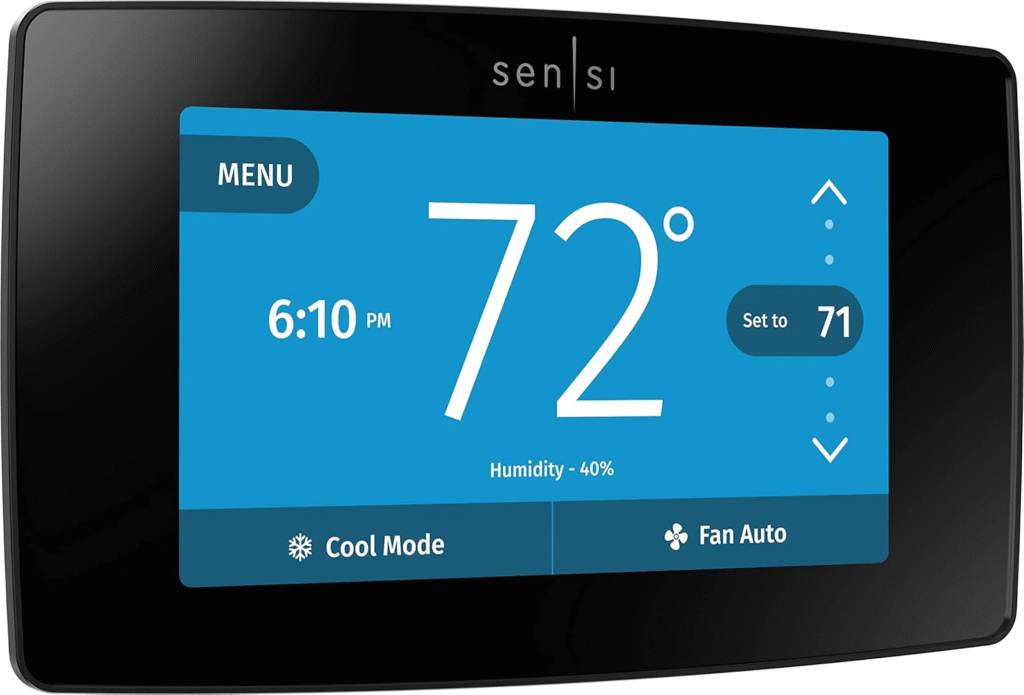
- Mysa Smart Thermostat – Best for electric/baseboard heating. If you heat with electric baseboards or convectors (common in some apartments), Mysa ($130) is a top choice. It works with Wi-Fi and plays nicely with Alexa or Google Home. Reviews mention it offers “efficient energy monitoring” and broad compatibility. The sleek design is minimal but the app gives good control. This is the go-to model if you have non-furnace systems. (Amazon USA –)
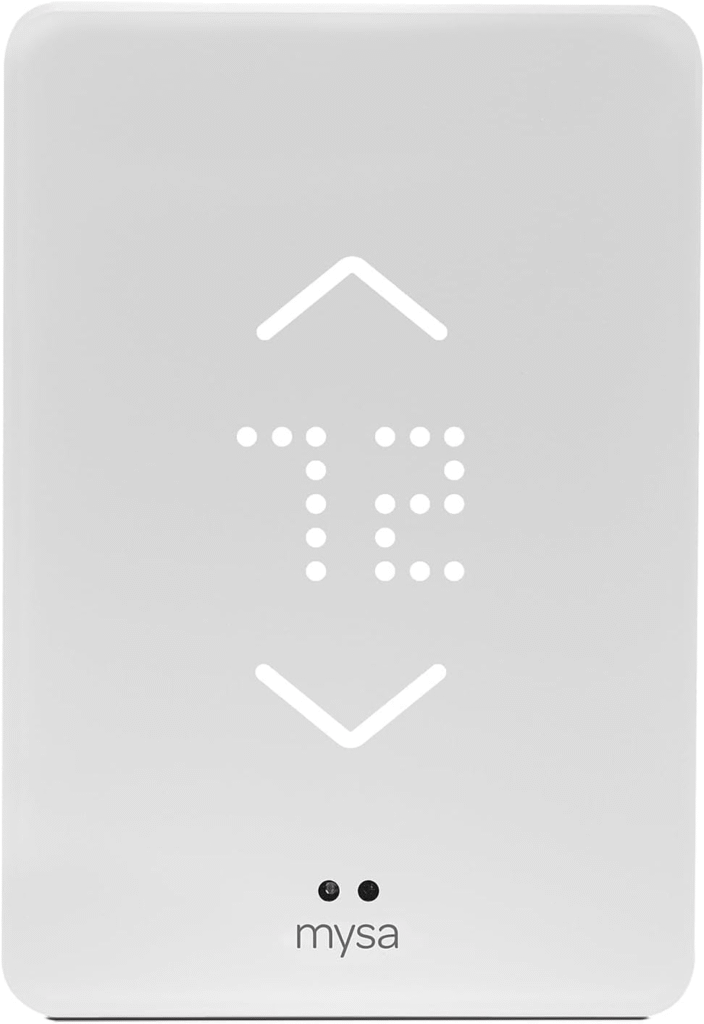
- Google Nest Thermostat E – Beginner-friendly option. This simpler Nest (about $110) is very easy to install and use. TechRadar calls it “simple to install, easy to use, and covers all the essentials”. It learns a bit and can be voice-controlled, though it doesn’t have all the bells of the Gen 4. For renters or those who want an affordable entry into smart thermostats, the Nest E (primarily in UK/Canada) is recommended.

Best Smart Thermostat 2025: Buying Guide
Choosing the right smart thermostat depends on your home and goals. Here are some tips (consider this your smart thermostat buying guide):
- Compatibility & Wiring: Make sure the thermostat works with your heating/cooling system (gas, heat pump, radiators, etc.). Most require a common C-wire for power. For instance, the Amazon model “requires a C-wire”, and the Emerson Sensi often does too. If you don’t have a C-wire, look for one that includes a power adapter, or choose a model like the Nest Thermostat E (UK) which doesn’t need it.
- Smart Home Ecosystem: Think about voice assistant and hub compatibility. Do you live in an Alexa, Google, or Apple HomeKit household? The Hive Thermostat 2024 is a great example – it’s “compatible with Alexa, Google Home, and Apple HomeKit”, so it plays well with all platforms. Ecobee Premium has Alexa built-in, Nest works with Google (and with Alexa devices, though not HomeKit), and Sensi supports Siri/Apple. Choose a thermostat that matches the voice assistants you already use.
- Whole-Home vs Zonal Control: Some systems only control one main zone (the whole HVAC), while others let you set different temps per room. For example, Honeywell’s Evohome allows zonal control by adding smart radiator valves, so you only heat occupied rooms. This saves more energy but costs more to install. If your goal is max savings and you have a multi-zone system, consider a zonal setup. Otherwise, a single-unit thermostat is simpler and cheaper.
- Learning & Features: Some thermostats (like Nest) automatically learn your schedule; others require you to program more manually. Decide if you want full automation or like tweaking settings yourself. Also check if it has extras you want: remote sensors (for multi-room), humidity sensors, bright touchscreens, color displays, etc. A thorough review, for instance, highlighted that the Ecobee Enhanced “scored 8/10 in our tests for its energy-saving features and smart platform compatibility” – meaning it handles schedules, occupancy, and platform support well.
- Price & Value: Budget models (Amazon, Wyze) can still save energy, but premium ones have fancier features. Often, paying more means extra convenience (color screen, multiple sensors, voice speakers). However, even a basic smart thermostat will reduce waste compared to a manual one.
In short, match your choice to your priorities: ease of use, budget, existing smart home tech, and how much you want to automate versus manually control. Remember that any reputable smart thermostat (especially ENERGY STAR models) will be a significant upgrade over a “dumb” thermostat.
Best Smart Thermostat 2025: Nest vs Ecobee Showdown
A common question is “Nest or Ecobee – which is better?” The answer often depends on your smart home preferences. Tom’s Guide calls the Ecobee SmartThermostat Premium “the best smart thermostat” in its tests, largely because it includes a built-in Alexa and room sensors. The Ecobee Premium (about $250) has a nice touchscreen and comes with a remote sensor that detects occupancy, so it avoids heating empty rooms. If you use lots of Alexa devices, this could be ideal.
On the other hand, Google’s new Nest Learning Thermostat Gen 4 (priced ~$280) just added big upgrades: a beautiful edge-to-edge display and an AI that reacts to outside weather, “saving even more money on your energy bills”. It now supports Matter (so it’ll work with most hubs going forward). It doesn’t have Alexa built-in, but you can still ask Alexa or Google to change the temperature. In short, Nest wins on design and AI smarts, while Ecobee wins on voice integration and out-of-the-box sensors. I often recommend: if you’re all-in on the Google ecosystem, go Nest. If you rely on Amazon/Alexa or need multiple sensors, go Ecobee. Both will shrink your bills – studies suggest they’ll each save roughly 10–15% on heating/cooling use.
A side-by-side of Google’s Nest (left) and Ecobee (right). Both top-tier smart thermostats for 2025, each excelling in different ways. Nest focuses on sleek design and AI scheduling, while Ecobee offers built-in Alexa and room sensors for precise control.
Best Smart Thermostat 2025: Voice Control and Compatibility
Think of the best smart thermostat 2025 as part of your whole smart-home puzzle. Most top thermostats integrate with at least one voice assistant. For example, Hive Thermostat (2024) is noted for being easy to use and “compatible with Alexa, Google Home, and Apple HomeKit”. That means you can shout “Hey Siri, set the heating to 72°F” or “Alexa, turn off the air conditioning,” and it will obey. The Nest Gen4 works with Google Assistant natively and Alexa via a skill. Ecobee Premium even has Alexa on board, so it can answer questions or play music. If you’re an Apple fan, make sure the thermostat supports HomeKit (only some do – Nest’s newest in the US unfortunately doesn’t, but older models or others like Honeywell’s Lyric do). Always check the compatibility list: if you use multiple systems, pick a thermostat that plays nice with all of them. In any case, all our top picks here support at least Alexa and Google out of the box, so voice control is almost guaranteed.
Best Smart Thermostat 2025: Energy Comparison Chart
To help you compare, here’s a quick overview of key 2025 models (with approximate prices and highlights):
- Google Nest Learning Thermostat (Gen 4) – ~$279, self-learning, AI scheduling (Matter-compatible).
- Ecobee SmartThermostat Premium – ~$249, built-in Alexa, remote occupancy sensor included.
- Amazon Smart Thermostat – ~$50–80, simple Alexa-based control (requires C-wire).
- Honeywell Home Smart Color – ~$180, customizable color display, energy usage insights.
- Emerson Sensi Touch – ~$147, user-friendly touchscreen, works with Alexa/Google/HomeKit.
- Mysa Smart Thermostat – ~$134, for electric baseboards, Alexa/Google compatible.
- Google Nest Thermostat E – ~$110, easy-install, covers basics for beginners.
This “chart” shows trade-offs: Amazon’s is cheapest, Nest is priciest but most advanced, Ecobee balances price/features, etc. Use these notes to decide what matters most (cost vs. features, voice vs. ecosystem, etc.).
Best Smart Thermostat 2025: Frequently Asked Questions
Q: What is the best smart thermostat 2025?
A: There’s no one-size-fits-all answer. Industry reviewers often cite Google’s Nest Learning Thermostat (Gen 4) and Ecobee SmartThermostat Premium as the top contenders for 2025. The Nest leads in design and AI-driven savings, while the Ecobee excels with sensors and Alexa. On a budget, Amazon’s thermostat or the Nest Thermostat E are excellent choices. Ultimately, “best” means the one that fits your home’s heating system and your smart home ecosystem.
Q: How much can a smart thermostat save me?
A: Typical savings range from about 8% to 15% on heating/cooling bills. For example, ENERGY STAR estimates you’ll use ~8% less energy (around $50/year in the US) with one installed. Other studies put the figure even higher (10–15%). The exact amount depends on your home and habits, but most people see tangible savings over a standard manual thermostat. Plus, it’s super convenient.
Q: What is the best smart thermostat for a home?
A: For a typical home, models like Nest, Ecobee, or the Amazon thermostat are top picks. If you have a single-zone HVAC (common), any will do. If you have radiators or multiple zones, consider a system like Honeywell Evohome or adding smart radiator valves. Our guide above lists top home-friendly models.
Q: Which smart thermostat is best on Reddit/smarthome forums?
A: Online discussions often praise Nest and Ecobee the most. Many homeowners on Reddit’s r/smarthome debate Nest vs. Ecobee, but the consensus echoes expert reviews: both are great and it depends on your preferences. We lean on expert reviews for objectivity.
Q: What features should I look for? (Smart thermostat buying guide)
A: Key features: compatibility with your heating system, voice assistant support (Alexa/Google/Siri), whether it needs a C-wire, and any additional perks (color display, sensors, geofencing). For example, TechRadar advises checking if the thermostat matches your home’s wiring and platform. A good approach is to list your must-haves (e.g. “must work with Alexa” or “must not need a new wire”) and pick a model that ticks those boxes.
Q: What is the best learning smart thermostat?
A: The term “learning thermostat” originally referred to Nest (it learns your habits). The Nest Learning Thermostat (Gen 4) still uses advanced algorithms to adapt to your schedule. Ecobee also learns to some extent via its sensors. So if “learning” is your priority, Nest is typically the benchmark.
Q: Do I need professional help to install?
A: You can install many smart thermostats yourself, but it involves dealing with wires. TechRadar’s guides suggest caution: if you’re unfamiliar with HVAC wiring, it might be safer to call a pro. Some thermostats (like Amazon’s) come with detailed app instructions and easy setups, so DIY is doable. Just always turn off power and double-check your wiring type before starting.
Q: Can I replace my old thermostat with a smart one?
A: Yes – smart thermostats are designed to replace traditional ones. Just make sure you match the wiring (especially the voltage). If in doubt, an electrician or HVAC technician can do the swap safely.
Q: How do I save the most energy with a smart thermostat?
A: Use its smart features! Set up geofencing so it turns down when you’re out. Let it learn your routine instead of manually programming every day. Also, use scheduling for nights or work hours. Even small changes help – for example, using the app to turn off the heat when you leave for vacation. As one reviewer noted, if you’re away and can turn off the system remotely, you avoid “running full blast in an empty house”. Over time, those habits really add up in savings.
I hope this guide helps you find the best smart thermostat 2025 for your home. Whether you’re a tech newbie or a smart-home pro, there’s a model that will fit your lifestyle. With the right choice, you’ll enjoy cozy comfort, lower bills, and the satisfaction of being a bit more eco-friendly.